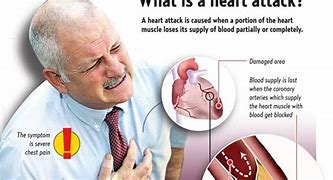
Heart attack can be lethal without immediate management of Best Cardiologist in Lahore. Its symptoms, therefore, need quick assessment and action. With swift action damage to the heart muscle can be minimized. Read to know the immediate signs and symptoms of heart attack and its management:
What is myocardial infarction or heart attack?
A heart attack or myocardial infarction is when the blood flow to the heart muscle is severely impeded or blocked thereby causing tissue death and infarction. This blockage is the direct consequence of fat-buildup in the coronary blood vessels, a process known as atherosclerosis.
Sometimes, the blockage is due to a blood clot or embolus from another part of the body that blocks the coronary blood flow. Subsequently, the heart muscle or the myocardium is deprived of blood and oxygen, causing the tissue to die.
With immediate management, the blood flow to the heart muscle can be restored and the damage can be minimized. The longer the heart tissue is deprived of blood and oxygen, the greater the damage will be.
What are the symptoms of heart attack?
The symptoms of heart attack can vary depending on the extent of blockage in the vasculature. Commonly, the symptoms are:
- Cold sweats
- Chest pain
- Pressure, tightness in the chest
- Light headedness
- Anxiety or feeling of doom
- Discomfort or pain that radiates to the left arm, jaw, teeth, back, neck
- Heaviness in the stomach
- Heartburn or feeling of indigestion particularly in inferior wall myocardial infarction
- Nausea and vomiting
- Pallor of face
- Shortness of breath or dyspnea
- Severe weakness
- Uneven heartbeat or palpitations as if the heart is skipping beats
- In diabetics, heart attack can present without any symptoms. This is called ‘silent’ heart attack.
What are the causes of heart attack?
Heart attack is caused by blockage of blood and oxygen flow to the heart muscle. Each coronary vessel supplies different part of the heart and therefore, how much muscle is damaged depends on the location of the blocked vessel and the time between block and commencement of treatment.
- Atherosclerosis: this is by far the commonest cause of heart attack. With atherosclerosis, there is buildup of fatty deposits in the coronary vasculature, causing decrease in the blood supply of the heart muscle. Atherosclerosis is an age-related process and is higher in people who consume excessive fatty food, have family history of atherosclerosis and those who do not workout.
If the plaque cracks, platelets can come to form blood clot around this plaque. In this case, as well, the blood flow to the heart muscle is blocked causing myocardial infarction.
- Coronary artery disease: in coronary artery disease there is narrowing of the coronary vessels. CAD presents with pain on exertion, called angina, which typically gets better on rest. Angina can herald an impending heart attack.
- Coronary artery spasm: spasm of the coronary vasculature can contribute to heart disease. During this spasm, the arteries contract and impede the blood supply to the heart. This type of coronary artery spasm can also induce a particular type of angina called prinzmetal angina. Unlike typical angina which starts on activity, prinzmetal angina can start at rest.
How is a heart attack diagnosed?
Heart attack is diagnosed with the following investigations:
- Electrocardiogram: an ECG or electrocardiogram records the electrical activity of the heart. Through an ECG, the extent of heart muscle damage and its location can be recorded precisely. It can also record any changes in heart rate and rhythm.
- Cardiac enzymes: blood tests measuring the cardiac enzymes levels help to diagnose heart attack, as well. These cardiac enzymes are released from the damaged heart muscle due to infarction.
- Cardiac catheterization: is used to both diagnose and treat blocked coronary vessels.
What are the management options?
The treatment options include:
- Antiplatelet drugs: such as aspirin and clopidogrel are loaded to stop the clotting process.
- Oxygen: high flow oxygen is given to the patient.
- Balloon angioplasty: is done through cardiac catheterization to open blocked and narrowed vessels.
- Stents: can also be placed to prop open the vessels.
- CABG: by-pass surgery can be done to restore blood flow to the heart at Shaafi International Hospital